-
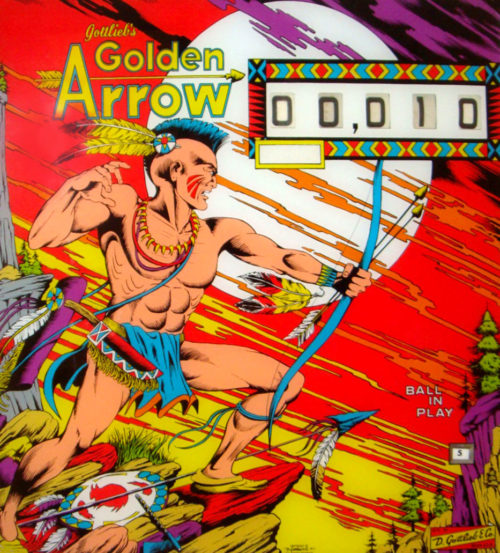 Here’s another example of a Gottlieb single-player mechanical game when all the other manufacturers during this period were developing solid-state computerized machines. Ed Krynski is the designer with Gordon Morison the artist of choice for this model, one of 1,530 machines made. The machine itself is a classic ’70s. Ten numbers is your goal here. You achieve these ten targets by hitting and rolling over the appropriate spots on the playfield. Hitting the spinner spots the numbered target the spinner stops on. If you’re lucky to complete the targets, the special lights up and advances through the ten numbers. Hitting the lighted number with “special” lit means more free time playing the game. Score for replays is your second goal. Nice artwork in a single player game, one of the last produced.
Here’s another example of a Gottlieb single-player mechanical game when all the other manufacturers during this period were developing solid-state computerized machines. Ed Krynski is the designer with Gordon Morison the artist of choice for this model, one of 1,530 machines made. The machine itself is a classic ’70s. Ten numbers is your goal here. You achieve these ten targets by hitting and rolling over the appropriate spots on the playfield. Hitting the spinner spots the numbered target the spinner stops on. If you’re lucky to complete the targets, the special lights up and advances through the ten numbers. Hitting the lighted number with “special” lit means more free time playing the game. Score for replays is your second goal. Nice artwork in a single player game, one of the last produced. -
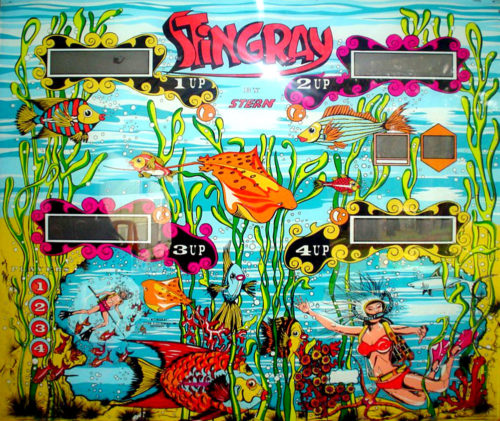 Here’s a 1977 Stern ‘Pinball’. This was Stern’s first solid state machine and marked the beginning of a long and interesting history for the company. Designed by Mike Kubin, it’s a fast game that has some wicked out-lanes and very quick ball times. There are no mini-posts above the out-lane guides which make controlling the ball near the out-lanes very difficult. Stingray, the game made by Stern following ‘Pinball’ also lacked these posts, but games made thereafter had the posts which dramatically improve the player’s ability to control the ball and avoid the out-lane. This game has a basic rule-set. Knock down the 5 drop targets twice in one ball to score the special. The saucer on the right side of the playfield awards a somewhat random award and the spinner shot on the left is a very satisfying shot to hit.
Here’s a 1977 Stern ‘Pinball’. This was Stern’s first solid state machine and marked the beginning of a long and interesting history for the company. Designed by Mike Kubin, it’s a fast game that has some wicked out-lanes and very quick ball times. There are no mini-posts above the out-lane guides which make controlling the ball near the out-lanes very difficult. Stingray, the game made by Stern following ‘Pinball’ also lacked these posts, but games made thereafter had the posts which dramatically improve the player’s ability to control the ball and avoid the out-lane. This game has a basic rule-set. Knock down the 5 drop targets twice in one ball to score the special. The saucer on the right side of the playfield awards a somewhat random award and the spinner shot on the left is a very satisfying shot to hit. -
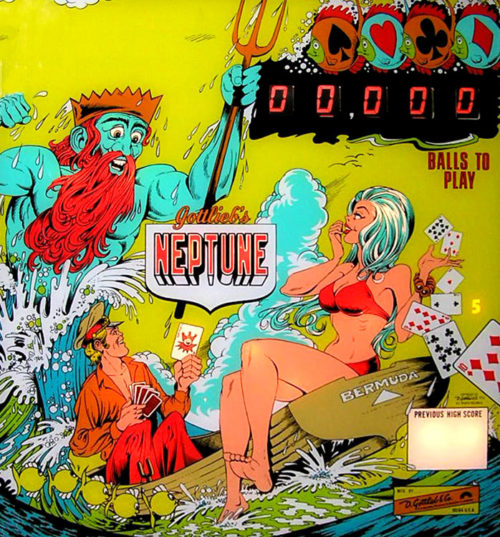 This rare add-a-ball game was released in April. It was designed by John Osbourne with artwork by Gordon Morison. A minimal total of 270 units were soldered together at the time. This is a small number for a pinball run. The replay version had a much larger production and the name of that game was Hit The Deck. As you can see from the backglass, Gottlieb tried to experiment with a score reel that was completely different in coloring. This was to attract attention to the game and attract quarters. The object of the game is to roll over the red number and/or black number sequence inherent in the game. If you are skillful enough to get the 9 to Ace sequence, some wow options will light up to score extra balls. A kickback feature is incorporated into the game in the upper-left area. This single-player game is challenging and a rare sight to see.
This rare add-a-ball game was released in April. It was designed by John Osbourne with artwork by Gordon Morison. A minimal total of 270 units were soldered together at the time. This is a small number for a pinball run. The replay version had a much larger production and the name of that game was Hit The Deck. As you can see from the backglass, Gottlieb tried to experiment with a score reel that was completely different in coloring. This was to attract attention to the game and attract quarters. The object of the game is to roll over the red number and/or black number sequence inherent in the game. If you are skillful enough to get the 9 to Ace sequence, some wow options will light up to score extra balls. A kickback feature is incorporated into the game in the upper-left area. This single-player game is challenging and a rare sight to see. -
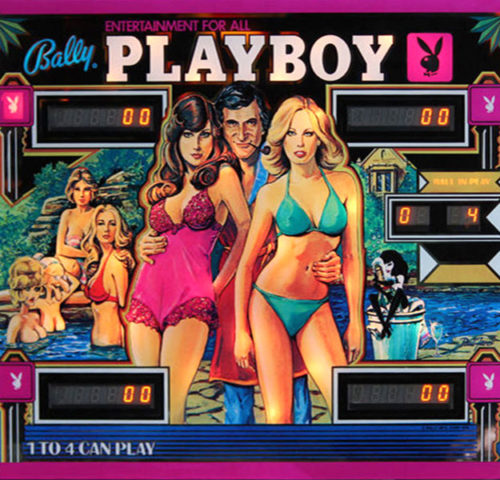 This solid-state game was very popular when it was released and has a lot of smooth shots to complete. It was designed by Jim Patla with artwork by Paul Faris. Production run was 18,250 units. This pre-speaking pinball has Hugh Hefner on its backglass with Bunny Sondra Theodore posing. At the top of the game are four rollover lanes, which advance when hit to a special and advance the bonuses and grotto award. Hitting the five Bunny targets also advance a feature to win extra balls and specials. A unique kickback lane advances with every entrance into it. A five-pack of drop targets also advance certain features on the game. If 20,000 points are made on the bonus system, this point count is carried over to all remaining balls and then some. The nicest shot on the game is going up the right side from the flipper and looping the ball into the grotto. The sound originates from the old TV show “Playboy After Dark.”
This solid-state game was very popular when it was released and has a lot of smooth shots to complete. It was designed by Jim Patla with artwork by Paul Faris. Production run was 18,250 units. This pre-speaking pinball has Hugh Hefner on its backglass with Bunny Sondra Theodore posing. At the top of the game are four rollover lanes, which advance when hit to a special and advance the bonuses and grotto award. Hitting the five Bunny targets also advance a feature to win extra balls and specials. A unique kickback lane advances with every entrance into it. A five-pack of drop targets also advance certain features on the game. If 20,000 points are made on the bonus system, this point count is carried over to all remaining balls and then some. The nicest shot on the game is going up the right side from the flipper and looping the ball into the grotto. The sound originates from the old TV show “Playboy After Dark.” -
Gottlieb released the game “Sinbad” in both solid-state and electromechanical formats in June of the year. Designed by Ed Krynski with art by Gordon Morison, there were 12,000 S.S. games and 950 E.M. games made. This machine is the rare two-player version of the game, of which 730 were made. Drop targets are the main theme of this game. Knocking down the single white drop target awards a 2x bonus and lights the white rollover. The three yellow drops were next. If hit, 3x bonus is awarded when the ball drains and the 5,000 rollover lights at the top of the playfield. The four purple drops were next. Making these would award 4x bonus and light the extra ball rollover. Finally, the five red drops; when hit would award 5x bonus (the maximum bonus that could register is 15,000 points times the bonus) as well as light the special rollover. Four flippers allowed for interesting play, also.
-
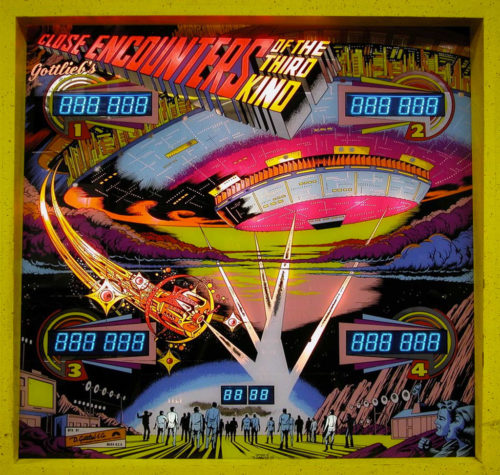 September was the month for the introduction of this game. Both solid-state and mechanical versions were produced (9,950 versus 550 units, respectively). Ed Krynski designed the machine with art by Gordon Morison. A roto-target was incorporated into the upper right of the game, a Gottlieb exclusive. Hitting the A-B-C rollovers lights up the extra ball target and increases the value of the roto-targets as well as the drop target values. Knocking down all the drop targets increases the bonus multiplier value. The second time this feat is completed lights the special roto-target value. This game also features a bonus advance bank which increases to 20,000 points and a two to five times bonus multiplier feature. Score is the other way to win games.
September was the month for the introduction of this game. Both solid-state and mechanical versions were produced (9,950 versus 550 units, respectively). Ed Krynski designed the machine with art by Gordon Morison. A roto-target was incorporated into the upper right of the game, a Gottlieb exclusive. Hitting the A-B-C rollovers lights up the extra ball target and increases the value of the roto-targets as well as the drop target values. Knocking down all the drop targets increases the bonus multiplier value. The second time this feat is completed lights the special roto-target value. This game also features a bonus advance bank which increases to 20,000 points and a two to five times bonus multiplier feature. Score is the other way to win games. -
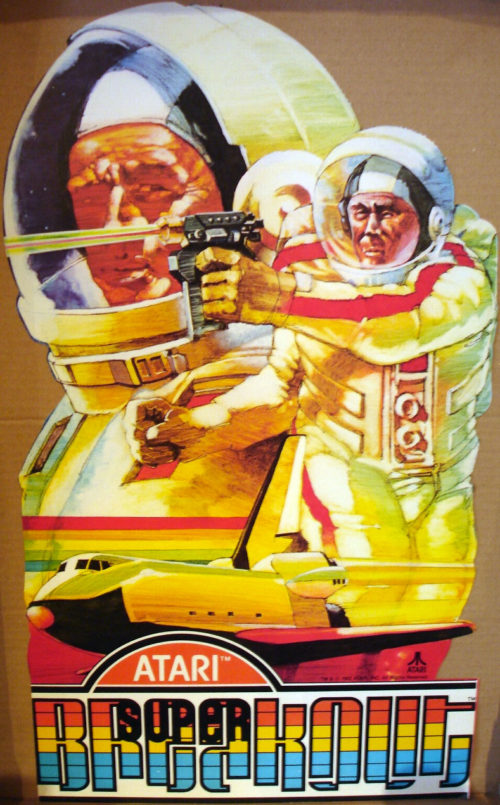 Move a paddle back and forth at the bottom of the screen to rebound a ball back into a brick wall, knocking bricks out one by one. There are three separate games: double — same as Breakout, knock down bricks and when they are all gone a new wall forms cavity — two other balls are inside the wall, when they have an escape route you can hit them as well progressive — as the wall is destroyed, new bricks are added and the entire wall shifts down toward your paddle. The sound effects are just simple beeps. This video game is a typical late ’70s machine which has been reproduced in many variations as well as downloaded apps on smartphones today. No complicated rules here, which is why it was so popular in its glory days. You control the horizontal paddle at the bottom of the playfield and, through the use of the spin controller, try to prevent losing the “ball” below the paddle. By aiming at the bricks, you try to hit all of them and then “break through” to the next layer of bricks. This accomplishment is rewarded with a period of high scoring and ricocheting video bounces of the “ball” until it escapes the brick layer and comes into your paddle again. These brick layers then start to drop toward your paddle. By the way, the TV is black and white!
Move a paddle back and forth at the bottom of the screen to rebound a ball back into a brick wall, knocking bricks out one by one. There are three separate games: double — same as Breakout, knock down bricks and when they are all gone a new wall forms cavity — two other balls are inside the wall, when they have an escape route you can hit them as well progressive — as the wall is destroyed, new bricks are added and the entire wall shifts down toward your paddle. The sound effects are just simple beeps. This video game is a typical late ’70s machine which has been reproduced in many variations as well as downloaded apps on smartphones today. No complicated rules here, which is why it was so popular in its glory days. You control the horizontal paddle at the bottom of the playfield and, through the use of the spin controller, try to prevent losing the “ball” below the paddle. By aiming at the bricks, you try to hit all of them and then “break through” to the next layer of bricks. This accomplishment is rewarded with a period of high scoring and ricocheting video bounces of the “ball” until it escapes the brick layer and comes into your paddle again. These brick layers then start to drop toward your paddle. By the way, the TV is black and white! -
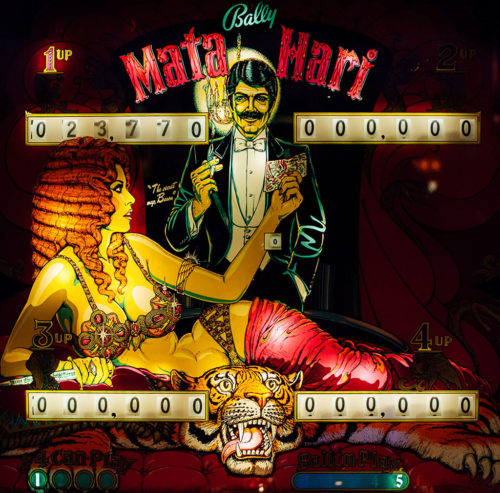 Mata Hari was released in April of the year and designed by Jim Patla with artwork accolades going to Dave Christiansen. 16,200 of these machines were produced in the new solid-state format (as seen in the museum) as well as bunch of electromechanical machines (170, to be exact) to keep the non-computer savvy operators happy and buying machines they knew how to fix. This machine before you is one of the finest examples of this ultra-rare mechanical format. Like the solid-state version, the center kickout hole scores 3,000 points and each successful shot in the hole advances the bonus multiplier. The A and B skill shots advance the horizontal sequence of increasing values in the center of the playfield. 50,000 points are awarded when a battery of drop targets is hit. If both batteries are knocked down, the drop targets reset and hitting all again awards the replay. Score is another replay option.
Mata Hari was released in April of the year and designed by Jim Patla with artwork accolades going to Dave Christiansen. 16,200 of these machines were produced in the new solid-state format (as seen in the museum) as well as bunch of electromechanical machines (170, to be exact) to keep the non-computer savvy operators happy and buying machines they knew how to fix. This machine before you is one of the finest examples of this ultra-rare mechanical format. Like the solid-state version, the center kickout hole scores 3,000 points and each successful shot in the hole advances the bonus multiplier. The A and B skill shots advance the horizontal sequence of increasing values in the center of the playfield. 50,000 points are awarded when a battery of drop targets is hit. If both batteries are knocked down, the drop targets reset and hitting all again awards the replay. Score is another replay option. -
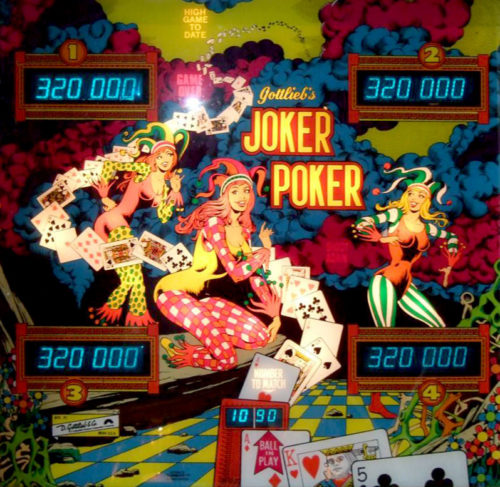 Gottlieb Joker Poker pinball. An interesting design, and only made in a 4 player version (no 2 player, unusual for Gottlieb pinball). One bank of five ace drop targets, one bank of four king drop targets, one bank of three jack targets, one bank of two queen drop targets, and a single ten drop target. Pretty cool pinball design really. Two pop bumpers, one slingshot, two 3″ flippers. They made 820 Gottlieb EM Joker Poker pinballs.
Gottlieb Joker Poker pinball. An interesting design, and only made in a 4 player version (no 2 player, unusual for Gottlieb pinball). One bank of five ace drop targets, one bank of four king drop targets, one bank of three jack targets, one bank of two queen drop targets, and a single ten drop target. Pretty cool pinball design really. Two pop bumpers, one slingshot, two 3″ flippers. They made 820 Gottlieb EM Joker Poker pinballs. -
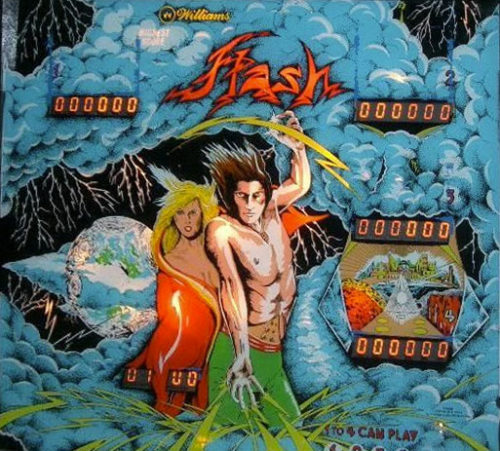 This game was a breakthru game for Williams in January. It was designed by Steve Ritchie with art by Constantino Mitchell. Flash was the first game to have a continous background sound during play and the crescendo of the sound sped up as you advanced thru the game. This is also the first game to use “flash lamps”, which are higher voltage lights that really make a presence when they light. The first thing you notice on this non-speaking game is, when you shoot the ball from the plunger, the ball travels diagonally across the playfield and ends at the top of the playfield from left to right. The top rollovers consist of 4 numbers. If you hit 1-3, you get a double bonus; all four made gives a triple bonus. 19,505 games were made, a big production run. This game also has the advance bonus eject hole, drop targets, and, of course, the bright “flash” show when activated. This game was a main staple in arcades of the ’80s.
This game was a breakthru game for Williams in January. It was designed by Steve Ritchie with art by Constantino Mitchell. Flash was the first game to have a continous background sound during play and the crescendo of the sound sped up as you advanced thru the game. This is also the first game to use “flash lamps”, which are higher voltage lights that really make a presence when they light. The first thing you notice on this non-speaking game is, when you shoot the ball from the plunger, the ball travels diagonally across the playfield and ends at the top of the playfield from left to right. The top rollovers consist of 4 numbers. If you hit 1-3, you get a double bonus; all four made gives a triple bonus. 19,505 games were made, a big production run. This game also has the advance bonus eject hole, drop targets, and, of course, the bright “flash” show when activated. This game was a main staple in arcades of the ’80s. -
 This game was a breakthru game. It is the first-ever talking pinball machine. Games of this era had synthesized sound, but this game spoke. The speech wasn’t very clear or very wordy, as memory chips of this era couldn’t hold too much information compared to today’s games, but it was a sensation for Williams. The production run for the game was 14,000 units. It was designed by Barry Oursler with art by Constantino Mitchell. The top three rollover lanes would, if completed give up two, then three times bonus. The snake pit in the upper-left playfield has a magnet under it, which captures the ball for bonuses and Gorgar’s chance to use his seven-word vocabulary. Spelling out the word “Gorgar” makes the monster say his name and increases bonus values. This game also incorporates the background noise made famous in the Williams game Flash (in the museum). This time the background sound is of a heartbeat. It gets faster and faster as you advance.
This game was a breakthru game. It is the first-ever talking pinball machine. Games of this era had synthesized sound, but this game spoke. The speech wasn’t very clear or very wordy, as memory chips of this era couldn’t hold too much information compared to today’s games, but it was a sensation for Williams. The production run for the game was 14,000 units. It was designed by Barry Oursler with art by Constantino Mitchell. The top three rollover lanes would, if completed give up two, then three times bonus. The snake pit in the upper-left playfield has a magnet under it, which captures the ball for bonuses and Gorgar’s chance to use his seven-word vocabulary. Spelling out the word “Gorgar” makes the monster say his name and increases bonus values. This game also incorporates the background noise made famous in the Williams game Flash (in the museum). This time the background sound is of a heartbeat. It gets faster and faster as you advance. -
 Yet another legendary, genre-defining game – in an era replete with genre-defining classics - in which a single player takes control of a ship trapped in the middle of an asteroid field. A number of large, slow-moving asteroids drift randomly around the play area and must be shot by the player. When shot, the asteroids will break into a number of smaller pieces, which must also be shot until, eventually, all of the asteroids and fragments will be destroyed and the next wave begins. Asteroids introduced real-world physics to video games for the first time, with speed and inertia all adding to the player’s problems. As well as the inertia of the player’s ship – forcing the player to allow for the ship slowing down and speeding up whenever the thrust button was utilized – shot asteroids would often send fragments flying in seemingly random directions, and at varying and unpredictable speeds. As well as the ever-present asteroids, alien saucers also make a regular appearance. These move diagonally around the screen, firing at the player’s ship and must be quickly destroyed.
Yet another legendary, genre-defining game – in an era replete with genre-defining classics - in which a single player takes control of a ship trapped in the middle of an asteroid field. A number of large, slow-moving asteroids drift randomly around the play area and must be shot by the player. When shot, the asteroids will break into a number of smaller pieces, which must also be shot until, eventually, all of the asteroids and fragments will be destroyed and the next wave begins. Asteroids introduced real-world physics to video games for the first time, with speed and inertia all adding to the player’s problems. As well as the inertia of the player’s ship – forcing the player to allow for the ship slowing down and speeding up whenever the thrust button was utilized – shot asteroids would often send fragments flying in seemingly random directions, and at varying and unpredictable speeds. As well as the ever-present asteroids, alien saucers also make a regular appearance. These move diagonally around the screen, firing at the player’s ship and must be quickly destroyed. -
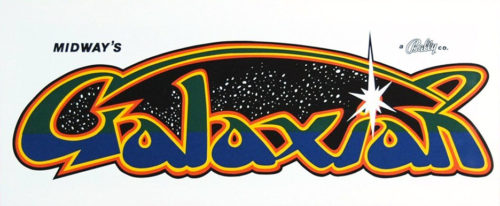 Galaxian (Gyarakushian?) is an arcade game that was developed by Namco and released in October 1979. It was published by Namco in Japan and imported to North America by Midway that December. A fixed shooter game in which the player controls a spaceship at the bottom of the screen, and shoots enemies descending in various directions, it was designed to compete with Taito Corporation’s successful earlier game Space Invaders (which was released in the previous year, and also imported to the US by Midway Games). The game was highly popular for Namco upon its release, and has been a focus of competitive gaming ever since. It spawned a successful sequel, Galaga, in 1981, and the lesser known Gaplus and Galaga ‘88 in 1984 and 1987 respectively, as well as many later ports and adaptations. Along with its immediate sequel, it was one of the most popular games during the golden age of arcade video games. Galaxian expanded on the formula pioneered by Space Invaders. As in the earlier game, Galaxian features a horde of attacking aliens that exchanged shots with the player. In contrast to Space Invaders, Galaxian added an element of drama by having the aliens periodically make kamikaze-like dives at the player’s ship, the Galaxip.[1] This made it the first game to feature enemies with individual personalities.[2] The game’s plot consists of a title screen that displayed the message “WE ARE THE GALAXIANS / MISSION: DESTROY ALIENS”.[3] Galaxian was very successful for Namco and introduced several “firsts”. Although not the first color video game, Galaxian took RGB color graphics a step further with multi-colored animated sprites and explosions, different colored fonts for the score and high score, the scrolling starfield, and graphic icons that show the number of lives left and how many stages the player had completed. It also features a crude theme song and more prominent background “music.” These elements combine to create a look and feel that would set the standard for arcade games in the 1980s such as Pac-Man. Gameplay The gameplay is relatively simple. Swarm after swarm of alien armies attack the player’s ship that moves left and right at the bottom of the wraparound screen. The ship can only have one shot on screen at a time. The player defeats one swarm, only to have it replaced by another more aggressive and challenging swarm in the next stage. A plain and repetitive starfield scrolls in the background.
Galaxian (Gyarakushian?) is an arcade game that was developed by Namco and released in October 1979. It was published by Namco in Japan and imported to North America by Midway that December. A fixed shooter game in which the player controls a spaceship at the bottom of the screen, and shoots enemies descending in various directions, it was designed to compete with Taito Corporation’s successful earlier game Space Invaders (which was released in the previous year, and also imported to the US by Midway Games). The game was highly popular for Namco upon its release, and has been a focus of competitive gaming ever since. It spawned a successful sequel, Galaga, in 1981, and the lesser known Gaplus and Galaga ‘88 in 1984 and 1987 respectively, as well as many later ports and adaptations. Along with its immediate sequel, it was one of the most popular games during the golden age of arcade video games. Galaxian expanded on the formula pioneered by Space Invaders. As in the earlier game, Galaxian features a horde of attacking aliens that exchanged shots with the player. In contrast to Space Invaders, Galaxian added an element of drama by having the aliens periodically make kamikaze-like dives at the player’s ship, the Galaxip.[1] This made it the first game to feature enemies with individual personalities.[2] The game’s plot consists of a title screen that displayed the message “WE ARE THE GALAXIANS / MISSION: DESTROY ALIENS”.[3] Galaxian was very successful for Namco and introduced several “firsts”. Although not the first color video game, Galaxian took RGB color graphics a step further with multi-colored animated sprites and explosions, different colored fonts for the score and high score, the scrolling starfield, and graphic icons that show the number of lives left and how many stages the player had completed. It also features a crude theme song and more prominent background “music.” These elements combine to create a look and feel that would set the standard for arcade games in the 1980s such as Pac-Man. Gameplay The gameplay is relatively simple. Swarm after swarm of alien armies attack the player’s ship that moves left and right at the bottom of the wraparound screen. The ship can only have one shot on screen at a time. The player defeats one swarm, only to have it replaced by another more aggressive and challenging swarm in the next stage. A plain and repetitive starfield scrolls in the background. -
 This wide-body solid-state game was a high-production model with 6,800 units produced. The artwork was Gordon Morison’s creation with Ed Krynski penning the playfield. This pre-vocal machine is jam-packed with features. A mini playfield in the upper left consists of drop targets which, when completed correctly, light extra ball and special targets on the main playfield. Hitting a, b, c, and d on the top rollovers lights an extra ball feature on the mini playfield. Hitting the yellow star drop targets advances the multiplier bonus up to a 5x level. Interesting side drain configurations as well as the potential to score the kick-out hole playfield bonus prior to draining a ball is interesting. Five flippers grace the game. All in all, a great package and interesting flow for an early wide-body creation.
This wide-body solid-state game was a high-production model with 6,800 units produced. The artwork was Gordon Morison’s creation with Ed Krynski penning the playfield. This pre-vocal machine is jam-packed with features. A mini playfield in the upper left consists of drop targets which, when completed correctly, light extra ball and special targets on the main playfield. Hitting a, b, c, and d on the top rollovers lights an extra ball feature on the mini playfield. Hitting the yellow star drop targets advances the multiplier bonus up to a 5x level. Interesting side drain configurations as well as the potential to score the kick-out hole playfield bonus prior to draining a ball is interesting. Five flippers grace the game. All in all, a great package and interesting flow for an early wide-body creation. -
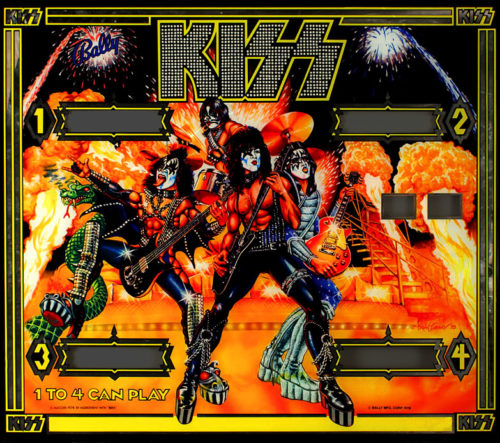 This very collectible game of the ‘70s was another in a series of celebrity-themed tie-in games Bally found license to produce. 17,000 units were made, a sizable number for the day. A prototype speaking version of this game was made ahead of its time but failed to be marketed. The object of the game is to spell out the name KISS. If you complete four times, a super bonus is awarded. Do it again and a colossal bonus is awarded. A third time awards a replay and a ton of points…which can be doubled if the 2x value drop targets are completed. The A, B, C, and D targets also can award extra balls and specials. The left drop targets award the KISS line when completed. All in all, an exciting game with great graphics but no speech. Talking pinballs finally made the scene with the release of Gorgar (in the museum). Replays are also awarded by score or matching. Matching is the process by which the last two numbers of your score match the generated number produced by the game.
This very collectible game of the ‘70s was another in a series of celebrity-themed tie-in games Bally found license to produce. 17,000 units were made, a sizable number for the day. A prototype speaking version of this game was made ahead of its time but failed to be marketed. The object of the game is to spell out the name KISS. If you complete four times, a super bonus is awarded. Do it again and a colossal bonus is awarded. A third time awards a replay and a ton of points…which can be doubled if the 2x value drop targets are completed. The A, B, C, and D targets also can award extra balls and specials. The left drop targets award the KISS line when completed. All in all, an exciting game with great graphics but no speech. Talking pinballs finally made the scene with the release of Gorgar (in the museum). Replays are also awarded by score or matching. Matching is the process by which the last two numbers of your score match the generated number produced by the game. -
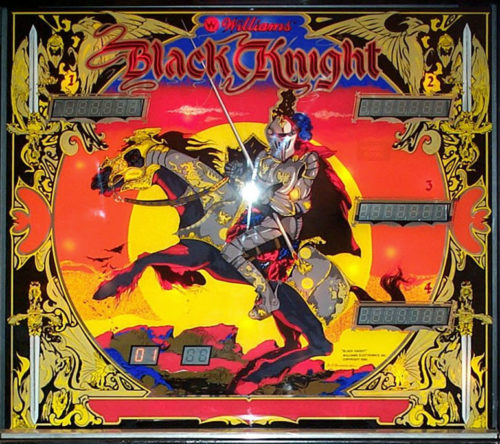 This game is another breakthru game by Williams. 13,075 units were made. Steve Ritchie designed the game and Tony Ramunni did the art package. Larry Demar programmed the game. Black Knight invented the “magna save” feature which is activated by the second flipper buttons on the side of the cabinet. When active, timing is critical. By activating this feature, the ball, which was about to drain down the side drains, is magically transported to the ball guide lane back to the flipper for continued play. This game also incorporated the “bonus ball” feature if more than one player was playing the game. The person with the highest score is awarded at the end of the game with a bonus round, which is timed to try and pop a game. Finally, this game is the first game to have a two-level playfield. Steve Ritchie, the designer, used his voice as the Black Knight.
This game is another breakthru game by Williams. 13,075 units were made. Steve Ritchie designed the game and Tony Ramunni did the art package. Larry Demar programmed the game. Black Knight invented the “magna save” feature which is activated by the second flipper buttons on the side of the cabinet. When active, timing is critical. By activating this feature, the ball, which was about to drain down the side drains, is magically transported to the ball guide lane back to the flipper for continued play. This game also incorporated the “bonus ball” feature if more than one player was playing the game. The person with the highest score is awarded at the end of the game with a bonus round, which is timed to try and pop a game. Finally, this game is the first game to have a two-level playfield. Steve Ritchie, the designer, used his voice as the Black Knight. -
 Defender is an arcade video game developed and released by Williams Electronics in 1980. A shooting game featuring two-dimensional (2D) graphics, the game is set on a fictional planet where the player must defeat waves of invading aliens while protecting astronauts. Development was led by Eugene Jarvis, a pinball programmer at Williams; Defender was Jarvis’ first video game project, and drew inspiration from Space Invaders and Asteroids. Defender is a two-dimensional side-scrolling shooting game set on the surface of an unnamed planet. The player controls a space ship as it navigates the terrain, flying either to the left or right. A joystick controls the ship’s elevation, and five buttons control its horizontal direction and weapons. The object is to destroy alien invaders, while protecting astronauts on the landscape from abduction. Humans that are successfully abducted return as mutants that attack the ship. Defeating the aliens allows the player to progress to the next level. Failing to protect the astronauts, however, causes the planet to explode and the level to become populated with mutants. Surviving the waves of mutants results in the restoration of the planet. Players are allotted three chances (lives) to progress through the game and are able to earn more by reaching certain scoring benchmarks. A life is lost if the ship comes into contact with an enemy or its projectiles. After exhausting all lives, the game ends. Defender is an arcade video game developed and released by Williams Electronics in 1980. A shooting game featuring two-dimensional (2D) graphics, the game is set on a fictional planet where the player must defeat waves of invading aliens while protecting astronauts. Development was led by Eugene Jarvis, a pinball programmer at Williams; Defender was Jarvis’ first video game project and drew inspiration from Space Invaders and Asteroids. Defender was one of the most important titles of the Golden Age of Arcade Games, selling over 55,000 units to become the company’s best selling game and one of the highest-grossing arcade games ever. Praise among critics focused on the game’s audio-visuals and gameplay. It is frequently listed as one of Jarvis’ best contributions to the video game industry as well as one of the most difficult video games. Defender was ported to numerous platforms, inspired the development of other games, and was followed by sequels and many imitations. Defender is a two-dimensional side-scrolling shooting game set on the surface of an unnamed planet. The player controls a space ship as it navigates the terrain, flying either to the left or right. A joystick controls the ship’s elevation, and five buttons control its horizontal direction and weapons. The object is to destroy alien invaders while protecting astronauts on the landscape from abduction. Humans who are successfully abducted return as mutants that attack the ship. Defeating the aliens allows the player to progress to the next level. Failing to protect the astronauts, however, causes the planet to explode and the level to become populated with mutants. Surviving the waves of mutants results in the restoration of the planet. Players are allotted three chances (lives) to progress through the game and are able to earn more by reaching certain scoring benchmarks. A life is lost if the ship comes into contact with an enemy or its projectiles. After exhausting all lives, the game end.
Defender is an arcade video game developed and released by Williams Electronics in 1980. A shooting game featuring two-dimensional (2D) graphics, the game is set on a fictional planet where the player must defeat waves of invading aliens while protecting astronauts. Development was led by Eugene Jarvis, a pinball programmer at Williams; Defender was Jarvis’ first video game project, and drew inspiration from Space Invaders and Asteroids. Defender is a two-dimensional side-scrolling shooting game set on the surface of an unnamed planet. The player controls a space ship as it navigates the terrain, flying either to the left or right. A joystick controls the ship’s elevation, and five buttons control its horizontal direction and weapons. The object is to destroy alien invaders, while protecting astronauts on the landscape from abduction. Humans that are successfully abducted return as mutants that attack the ship. Defeating the aliens allows the player to progress to the next level. Failing to protect the astronauts, however, causes the planet to explode and the level to become populated with mutants. Surviving the waves of mutants results in the restoration of the planet. Players are allotted three chances (lives) to progress through the game and are able to earn more by reaching certain scoring benchmarks. A life is lost if the ship comes into contact with an enemy or its projectiles. After exhausting all lives, the game ends. Defender is an arcade video game developed and released by Williams Electronics in 1980. A shooting game featuring two-dimensional (2D) graphics, the game is set on a fictional planet where the player must defeat waves of invading aliens while protecting astronauts. Development was led by Eugene Jarvis, a pinball programmer at Williams; Defender was Jarvis’ first video game project and drew inspiration from Space Invaders and Asteroids. Defender was one of the most important titles of the Golden Age of Arcade Games, selling over 55,000 units to become the company’s best selling game and one of the highest-grossing arcade games ever. Praise among critics focused on the game’s audio-visuals and gameplay. It is frequently listed as one of Jarvis’ best contributions to the video game industry as well as one of the most difficult video games. Defender was ported to numerous platforms, inspired the development of other games, and was followed by sequels and many imitations. Defender is a two-dimensional side-scrolling shooting game set on the surface of an unnamed planet. The player controls a space ship as it navigates the terrain, flying either to the left or right. A joystick controls the ship’s elevation, and five buttons control its horizontal direction and weapons. The object is to destroy alien invaders while protecting astronauts on the landscape from abduction. Humans who are successfully abducted return as mutants that attack the ship. Defeating the aliens allows the player to progress to the next level. Failing to protect the astronauts, however, causes the planet to explode and the level to become populated with mutants. Surviving the waves of mutants results in the restoration of the planet. Players are allotted three chances (lives) to progress through the game and are able to earn more by reaching certain scoring benchmarks. A life is lost if the ship comes into contact with an enemy or its projectiles. After exhausting all lives, the game end. -
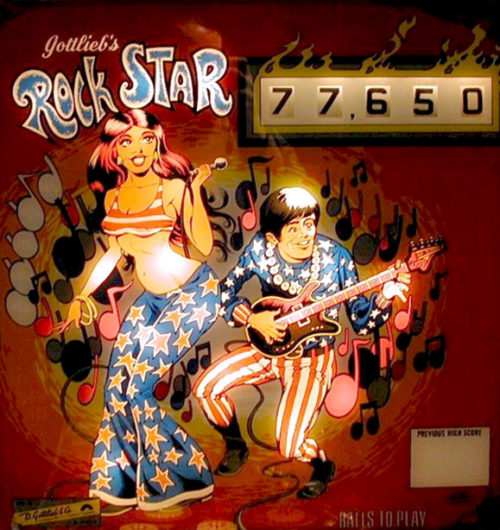 The game before you is extremely rare with only 278 screwed together at the Chicago Gottlieb factory. This one-player electromechanical add-a-ball game was designed by John Osbourne with art by Gordon Morison. A replay version was also designed by the name of Blue Note. The object of this machine is to complete all the notes down the left side of the playfield. Doing so activates the classic “wow” feature which, when hit, awards one free ball. A reset is in your future once your current ball drains. Score is another way to achieve longer play by winning extra balls. The spinner in the middle of the playfield awards big points when 1,000 points is lit; each spin of the target awards 1,000 points plus number of revolutions spun. A nice retro art package completes this rare machine.
The game before you is extremely rare with only 278 screwed together at the Chicago Gottlieb factory. This one-player electromechanical add-a-ball game was designed by John Osbourne with art by Gordon Morison. A replay version was also designed by the name of Blue Note. The object of this machine is to complete all the notes down the left side of the playfield. Doing so activates the classic “wow” feature which, when hit, awards one free ball. A reset is in your future once your current ball drains. Score is another way to achieve longer play by winning extra balls. The spinner in the middle of the playfield awards big points when 1,000 points is lit; each spin of the target awards 1,000 points plus number of revolutions spun. A nice retro art package completes this rare machine. -
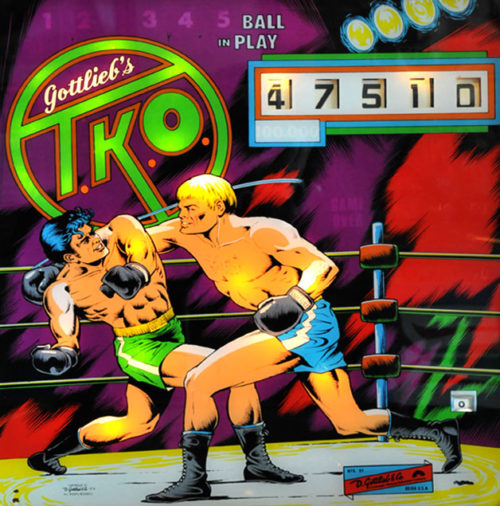 Look no further! If you’re searching for the rarest of the rare, here for your perusal is not one but two examples of this Gottlieb aberration. Supposedly only 125 were made of this game and most were sold overseas. Ed Krynski and Gordon Morison again teamed up to art and design the game. This game represents one of the last electromechanical “wedgehead” games ever built near the shores of Lake Michigan. It’s also a single-player game and one of the last. The object of the game is not really boxing in the true sense but hitting enough targets to advance the central advance display up to the top of the rack. This will ignite the special lights for a free game. The color-coordinated advance inserts on the play field correspond to the light-up features on the play field and, if you advance the light sequence accordingly, those features light up for the brief time the advance mechanism stays on that light. Score is the easiest way to win a replay.
Look no further! If you’re searching for the rarest of the rare, here for your perusal is not one but two examples of this Gottlieb aberration. Supposedly only 125 were made of this game and most were sold overseas. Ed Krynski and Gordon Morison again teamed up to art and design the game. This game represents one of the last electromechanical “wedgehead” games ever built near the shores of Lake Michigan. It’s also a single-player game and one of the last. The object of the game is not really boxing in the true sense but hitting enough targets to advance the central advance display up to the top of the rack. This will ignite the special lights for a free game. The color-coordinated advance inserts on the play field correspond to the light-up features on the play field and, if you advance the light sequence accordingly, those features light up for the brief time the advance mechanism stays on that light. Score is the easiest way to win a replay. -
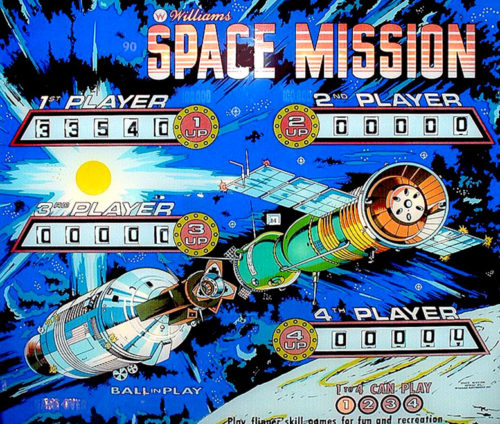 Space Mission was released in January, designed by Steve Kordek with artwork by Christian Marche. Production run was 11,652. This game was very successful for Williams and is considered to be the seventh most desirable game of the ’70s era.The game features a moving target as well as two side kickers next to the flippers for shots at the moving target. Making the A, B, or C light up the side eject holes to award a double bonus for the ball in play. If you were skillful enough to complete the A, B and C, the side outlanes light up for special. The top horshoe loop advances the bonus system. This game has a lot of nice shots and is fast paced. One doesn’t tire easily trying to achieve the scores needed to win a free game. This game was one of Steve’s Kordek’s favorite designs.
Space Mission was released in January, designed by Steve Kordek with artwork by Christian Marche. Production run was 11,652. This game was very successful for Williams and is considered to be the seventh most desirable game of the ’70s era.The game features a moving target as well as two side kickers next to the flippers for shots at the moving target. Making the A, B, or C light up the side eject holes to award a double bonus for the ball in play. If you were skillful enough to complete the A, B and C, the side outlanes light up for special. The top horshoe loop advances the bonus system. This game has a lot of nice shots and is fast paced. One doesn’t tire easily trying to achieve the scores needed to win a free game. This game was one of Steve’s Kordek’s favorite designs. -
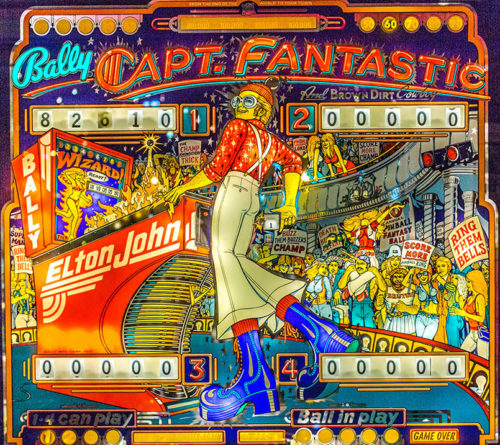 This game is considered to be the #3 game of the ’70s. It was released in June, designed by Greg Kmiec and art by Dave Christiansen. It had a production run of 16,200 units, a record to that date for production by Bally. The game has a rock star tie in the form of Elton John, who was at his peak back then. The movie “Tommy” was also an influence for the game’s graphics. The triple flipper arrangement of the game made for fast action on the playfield. A bonus feature is present, a 5-bank drop target that when hit, advances through extra ball and then special. A free ball gate, when activated, extends the ball’s life. This game is one of the last most collectible electromechanical-era games produced. It was the complementary game to Bally’s Wizard pinball which, again, found its theme based on the “Tommy” movie by The Who. Celebrity tie-ins were found to be big sellers.
This game is considered to be the #3 game of the ’70s. It was released in June, designed by Greg Kmiec and art by Dave Christiansen. It had a production run of 16,200 units, a record to that date for production by Bally. The game has a rock star tie in the form of Elton John, who was at his peak back then. The movie “Tommy” was also an influence for the game’s graphics. The triple flipper arrangement of the game made for fast action on the playfield. A bonus feature is present, a 5-bank drop target that when hit, advances through extra ball and then special. A free ball gate, when activated, extends the ball’s life. This game is one of the last most collectible electromechanical-era games produced. It was the complementary game to Bally’s Wizard pinball which, again, found its theme based on the “Tommy” movie by The Who. Celebrity tie-ins were found to be big sellers. -
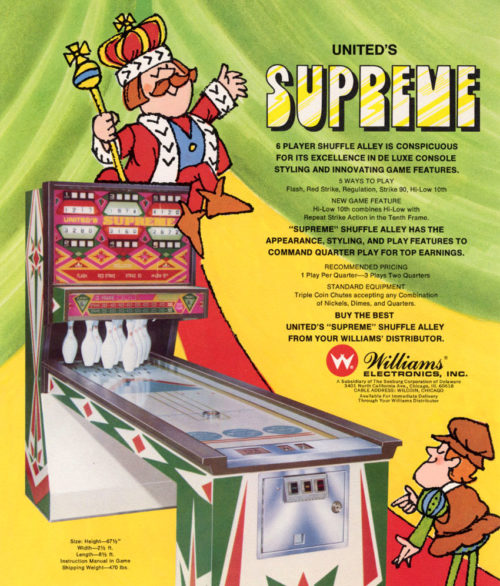
-
Two banks of 5 drop targets, with two kickout holes above the drop targets. Three pop bumpers, no slingshots, and two 3″ flippers. The game play/rules behind Fastdraw is rather interesting, and a bit complicated for an EM pinball. First try and score the three A-B-C rollover targets. This increases the score value of the two kickout holes (1000 points plus another 1000 for each of the scored A-B-C rollovers, for a possible 4000 points max per kickout hole). Each of the three rollovers corresponds to a pop bumper too, so scoring the “A” rollover lights its pop bumper scoring 100 points instead of 10 points. Getting the three A-B-C rollovers also turns on the “extra bonus” light (double bonus for all but the last ball). Last ball gets double bonus by default, and if the A-B-C rollover lanes are scored, triple bonus is awarded. After the A-B-C rollovers are scored, knocking down all 5 of either the right or left drop target banks will also light the corresponding right or left kickout hole for Special. (The center pop bumper alternates the Special between the right and left kickout hole.) Also each drop target knocked down increases the end-of-ball bonus by 1000 points. Finally, knocking down all 10 drop targets makes the game raise the single center black drop target on each of the two drop banks. Now this single drop target is worth 5000 points. If one of the two center black drop targets is down, again that corresponding kickout hole will alternate lit as Special (assuming the A-B-C rollovers have been scored). If both black single drop targets are knocked down, the game resets these two black drop targets again. At the end of ball all targets and features reset, so it’s rinse and repeat for the next ball/player.
-
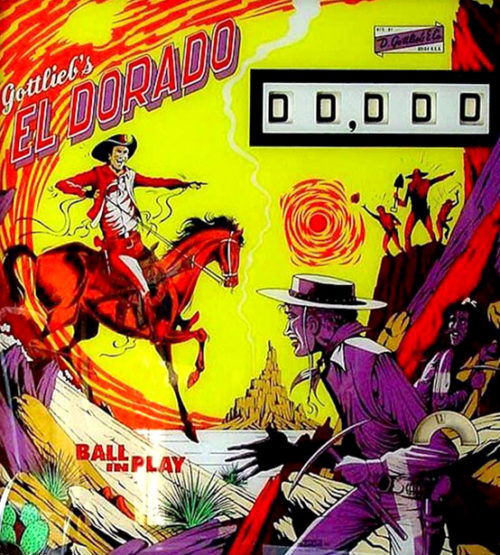 November marks the month of this game’s release. Design was one of Ed Krynski’s and art package was penned by Gordon Morison. This game had an add-a-ball version called Gold Strike as well as a re-released solid-state version. Gottlieb also duplicated this game design in Target Alpha (in the museum) and Canada Dry. 2,875 units were produced. If you like drop targets, this is your game. A battery of 10 drop targets are in the top of the playfield and a battery of 5 on the right mid-center. Four flippers are present for aiming at your foe. If you’re skillful enough to complete all the targets, a replay is awarded, 5,000 points are added, and a special lights up to score a replay if hit. If you drain your ball, the targets reset. An advancing light under the drop targets awards 5,000 points instead of the usual 500 points if you hit the drop target when it’s up and appropriately lit. Rollovers score 5,000 points when lit. Score awards replays also as well as matching.
November marks the month of this game’s release. Design was one of Ed Krynski’s and art package was penned by Gordon Morison. This game had an add-a-ball version called Gold Strike as well as a re-released solid-state version. Gottlieb also duplicated this game design in Target Alpha (in the museum) and Canada Dry. 2,875 units were produced. If you like drop targets, this is your game. A battery of 10 drop targets are in the top of the playfield and a battery of 5 on the right mid-center. Four flippers are present for aiming at your foe. If you’re skillful enough to complete all the targets, a replay is awarded, 5,000 points are added, and a special lights up to score a replay if hit. If you drain your ball, the targets reset. An advancing light under the drop targets awards 5,000 points instead of the usual 500 points if you hit the drop target when it’s up and appropriately lit. Rollovers score 5,000 points when lit. Score awards replays also as well as matching. -
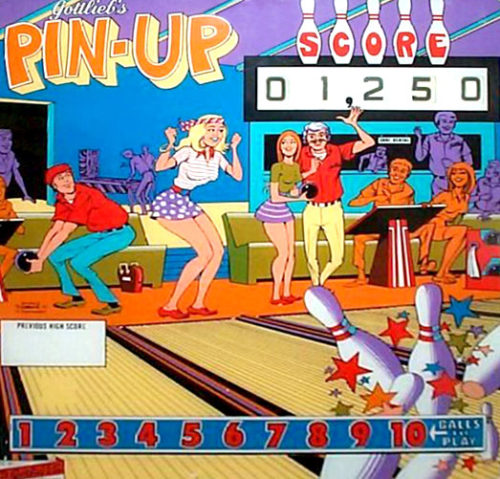 Gottlieb hatched this add-a-ball machine from the skunkworks in April of the year, designed by Ed Krynski and artwork by Gordon Morison. This single-player machine has a bowling theme and only 715 units were produced at that time. The replay version of the game was called King Pin and many more of these machines were produced. The theme of this game is the drop target completion. By carefully aiming the four inherent flippers on board the playfield, one must try to complete the horizontal row of targets. Doing so will reset the targets and the wow feature activates, giving you a shot at the accomplishment of winning extra balls. Score is another way to pop free balls. The ten drop targets are not so easy to complete and the wow feature advances when you roll over the star rollover. This game is challenging, but a beginner can have ample fun with the machine.
Gottlieb hatched this add-a-ball machine from the skunkworks in April of the year, designed by Ed Krynski and artwork by Gordon Morison. This single-player machine has a bowling theme and only 715 units were produced at that time. The replay version of the game was called King Pin and many more of these machines were produced. The theme of this game is the drop target completion. By carefully aiming the four inherent flippers on board the playfield, one must try to complete the horizontal row of targets. Doing so will reset the targets and the wow feature activates, giving you a shot at the accomplishment of winning extra balls. Score is another way to pop free balls. The ten drop targets are not so easy to complete and the wow feature advances when you roll over the star rollover. This game is challenging, but a beginner can have ample fun with the machine. -
 This game by Gottlieb is a very challenging design. It was invented by Ed Krynski and artwork was drawn by Gordon Morrison. This game has 10 drop targets lined up the left side of the playfield. If one target is hit, one scores 500 points. If, however, you’re skillful enough to hit a blue and white target at the same time, 5,000 points are awarded. Completing the sequence 1-9 lights the special at the bottom left rollover as well as lights the drop targets to score a special if all the targets are dropped. The player had to be wary when trying to freeze the ball on the right flipper, as one could lose the ball up the right guide rail (which has an opening in it the size of a ball). This playfield design was used a few times by Gottlieb, as it was a successful design (games like Gottlieb 300, for example, a bowling themed game). Scoring games by core were another option.
This game by Gottlieb is a very challenging design. It was invented by Ed Krynski and artwork was drawn by Gordon Morrison. This game has 10 drop targets lined up the left side of the playfield. If one target is hit, one scores 500 points. If, however, you’re skillful enough to hit a blue and white target at the same time, 5,000 points are awarded. Completing the sequence 1-9 lights the special at the bottom left rollover as well as lights the drop targets to score a special if all the targets are dropped. The player had to be wary when trying to freeze the ball on the right flipper, as one could lose the ball up the right guide rail (which has an opening in it the size of a ball). This playfield design was used a few times by Gottlieb, as it was a successful design (games like Gottlieb 300, for example, a bowling themed game). Scoring games by core were another option. -
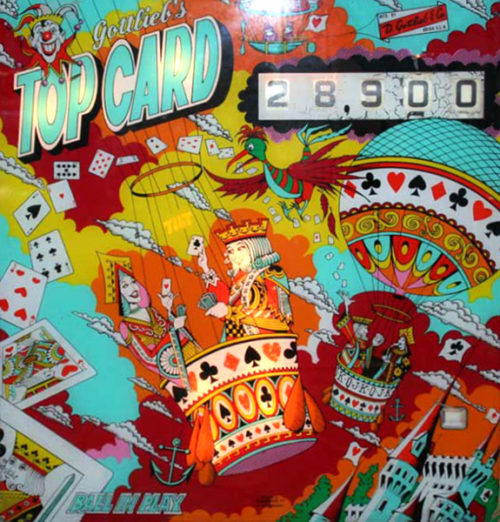 Here’s another classic single-player wedgehead. This machine was designed by Jeff Brenner with art scrolled by Gordon Morison. 3,100 units came to fruition as well as an add-a-ball called Royal Pair. This open playfield design allows for a lot of action mandated by flipper shots all the way up the playfield. The object of the game is simple…by completing all the card targets and rollovers, three specials light. Hitting the ace target up top or scoring a lit rollover awards a replay. Another unique feature built into this machine is the random rollover values one may capture. 10, 100 or 1,000 points may be scored by rolling over one of four rollover targets when lit. The shots to the targets must be precise to score from the flipper. The outlanes are unique in design as they are angled. A very interesting variation of a Gottlieb card theme machine.
Here’s another classic single-player wedgehead. This machine was designed by Jeff Brenner with art scrolled by Gordon Morison. 3,100 units came to fruition as well as an add-a-ball called Royal Pair. This open playfield design allows for a lot of action mandated by flipper shots all the way up the playfield. The object of the game is simple…by completing all the card targets and rollovers, three specials light. Hitting the ace target up top or scoring a lit rollover awards a replay. Another unique feature built into this machine is the random rollover values one may capture. 10, 100 or 1,000 points may be scored by rolling over one of four rollover targets when lit. The shots to the targets must be precise to score from the flipper. The outlanes are unique in design as they are angled. A very interesting variation of a Gottlieb card theme machine. -
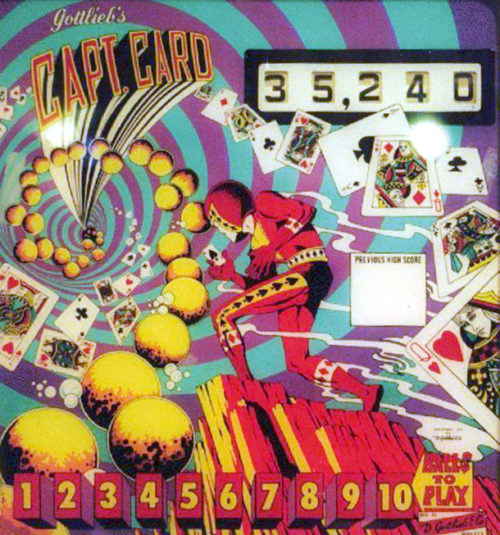 May was the release month for this game. Designer Ed Krynski and artist Gordon Morison put together the package. Production run was low, at 675 units. This is an add-a-ball game variant, the replay version was called High Hand. The challenging part of this playfield design is trying to lock a ball in the eject hole for extra balls. Four batteries of drop targets in four colors are along the sides of the playfield. Making a completion of a color of drop targets increases the value of the eject and side drains. If all the drop targets are completed, the extra ball features light up. Score is another way to win balls set by the operator. No match units were incorporated into these games as, again, that was considered a form of gambling, i.e. winning a free game.
May was the release month for this game. Designer Ed Krynski and artist Gordon Morison put together the package. Production run was low, at 675 units. This is an add-a-ball game variant, the replay version was called High Hand. The challenging part of this playfield design is trying to lock a ball in the eject hole for extra balls. Four batteries of drop targets in four colors are along the sides of the playfield. Making a completion of a color of drop targets increases the value of the eject and side drains. If all the drop targets are completed, the extra ball features light up. Score is another way to win balls set by the operator. No match units were incorporated into these games as, again, that was considered a form of gambling, i.e. winning a free game. -
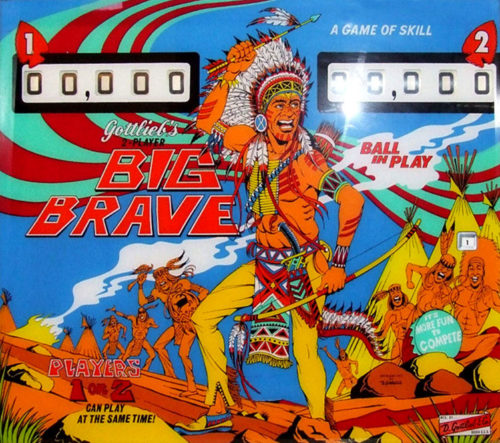 Big Brave is a two-player electromechanical machine. 3,450 units were produced. Ed Krynski designed the machine and Gordon Morison was in charge of the artwork. This game was a typical Gottlieb game of the era. It has drop targets, resetting targets, bonus feature, double bonus option, and a special. Making the B I G rollover lights the pop bumpers. Hitting all five drop targets awards 5,000 points. Hitting the last drop target left when the B I G is hit awards a special. The vari-target, as it was called, was an exclusive Gottlieb design. As you hit the target – depending how hard you hit it – would result in bigger point values. It will then reset to be hit again and again. A four-player version of this game, Big Indian, was also produced.
Big Brave is a two-player electromechanical machine. 3,450 units were produced. Ed Krynski designed the machine and Gordon Morison was in charge of the artwork. This game was a typical Gottlieb game of the era. It has drop targets, resetting targets, bonus feature, double bonus option, and a special. Making the B I G rollover lights the pop bumpers. Hitting all five drop targets awards 5,000 points. Hitting the last drop target left when the B I G is hit awards a special. The vari-target, as it was called, was an exclusive Gottlieb design. As you hit the target – depending how hard you hit it – would result in bigger point values. It will then reset to be hit again and again. A four-player version of this game, Big Indian, was also produced. -
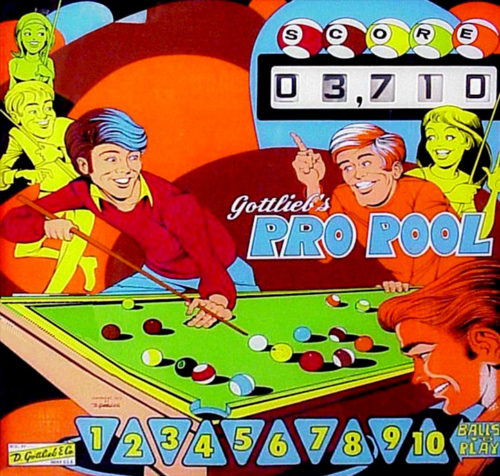 Pro Pool originated in December with 800 units being fabricated. This add-a-ball machine was designed by Ed Krynski with artwork by Gordon Morison. Two replay versions of the game were also made: a two-player version called Big Shot and a four-player version called Hot Shot. Obviously the theme of this game is the game of pool. The playfield is symmetrical and the way to win extra balls is by completing the left and/or right drop target battery. Doing so will lift the left and/or right wow rollovers for this award. The drop targets reset once the sequences are completed. Of course, an operator-adjusted score is another way to score a couple of balls. Back in the ‘70s, multiple balls or replays could be achieved on the game. Today, one free game on a current solid-state game is the common win. Operators have made it harder to achieve free games today as free games yield no income and only result in down time for the machine to earn coins in the till.
Pro Pool originated in December with 800 units being fabricated. This add-a-ball machine was designed by Ed Krynski with artwork by Gordon Morison. Two replay versions of the game were also made: a two-player version called Big Shot and a four-player version called Hot Shot. Obviously the theme of this game is the game of pool. The playfield is symmetrical and the way to win extra balls is by completing the left and/or right drop target battery. Doing so will lift the left and/or right wow rollovers for this award. The drop targets reset once the sequences are completed. Of course, an operator-adjusted score is another way to score a couple of balls. Back in the ‘70s, multiple balls or replays could be achieved on the game. Today, one free game on a current solid-state game is the common win. Operators have made it harder to achieve free games today as free games yield no income and only result in down time for the machine to earn coins in the till. -
 Williams produced this game in October with 7,053 units produced. Norm Clark designed the game and Christian Marche did the art package. This four-player electromechanical game is based on the game tic-tac-toe. Making 3 x’s or 3 o’s in line or diagonally lights the eject holes to award an extra ball and 5,000 points. Making the A and B rollovers lights the center target. Hitting it opens the gate and 1,000 points. A bonus feature is incorporated into the game and this is awarded when the ball drains. Lighting all the squares activates the side rollover lanes to score a replay. Score and matching are also incorporated into the game. A fast playfield design and fun to play.
Williams produced this game in October with 7,053 units produced. Norm Clark designed the game and Christian Marche did the art package. This four-player electromechanical game is based on the game tic-tac-toe. Making 3 x’s or 3 o’s in line or diagonally lights the eject holes to award an extra ball and 5,000 points. Making the A and B rollovers lights the center target. Hitting it opens the gate and 1,000 points. A bonus feature is incorporated into the game and this is awarded when the ball drains. Lighting all the squares activates the side rollover lanes to score a replay. Score and matching are also incorporated into the game. A fast playfield design and fun to play. -
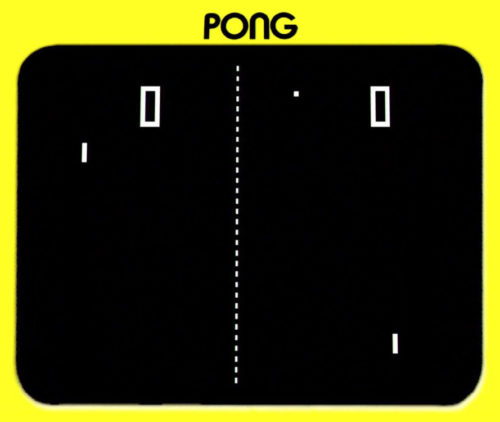 Atari PONG was released in June 1972 and is the first commercially successful video game and is based on a simple two-dimensional graphical representation of a tennis-like game. Players use paddles to hit a ball back and forth on a black and white screen. Pong was the first game developed by Atari Inc., by Nolan Bushnell and Ted Dabney. Pong (marketed as PONG) is one of the earliest arcade video games, and is a tennis sports game featuring simple two-dimensional graphics. The player controls an in-game paddle by moving it vertically across the left side of the screen, and can compete against either a computer controlled opponent or another player controlling a second paddle on the opposing side. Players use the paddles to hit a ball back and forth. The aim is for a player to earn more points than the opponent; points are earned when one fails to return the ball to the other. Pong consistently earned four times more revenue than other coin-operated machines, which resulted in an increase in the number of orders Atari received. This provided Atari with a steady source of income; the company sold the machines at three times the cost of production. By 1973, the company had filled 2,500 orders, and, at the end of 1974, sold more than 8,000 units.[20] The arcade cabinets have since become collector’s items with the cocktail-table version being the rarest. Atari eventually sold more than 35,000 units, however, many more imitations were produced by competitors.
Atari PONG was released in June 1972 and is the first commercially successful video game and is based on a simple two-dimensional graphical representation of a tennis-like game. Players use paddles to hit a ball back and forth on a black and white screen. Pong was the first game developed by Atari Inc., by Nolan Bushnell and Ted Dabney. Pong (marketed as PONG) is one of the earliest arcade video games, and is a tennis sports game featuring simple two-dimensional graphics. The player controls an in-game paddle by moving it vertically across the left side of the screen, and can compete against either a computer controlled opponent or another player controlling a second paddle on the opposing side. Players use the paddles to hit a ball back and forth. The aim is for a player to earn more points than the opponent; points are earned when one fails to return the ball to the other. Pong consistently earned four times more revenue than other coin-operated machines, which resulted in an increase in the number of orders Atari received. This provided Atari with a steady source of income; the company sold the machines at three times the cost of production. By 1973, the company had filled 2,500 orders, and, at the end of 1974, sold more than 8,000 units.[20] The arcade cabinets have since become collector’s items with the cocktail-table version being the rarest. Atari eventually sold more than 35,000 units, however, many more imitations were produced by competitors. -
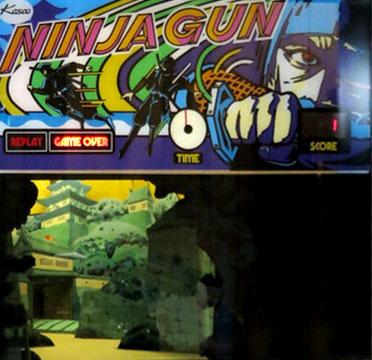 Kasco Manufacturing Company produced about eight machines of various themes in their productive commercial life. This machine is the most popular of the games they made. This shoot’em up game awards a free play if a score of 80 is made. The game board is elaborate for its day and looks 3-D. Blacklight, holograms, and mechanical chain link drives are all synchronized at different speeds (the faster the ninja moves, the more potential points you can earn if you hit one). Hitting a ninja produces a flash of light and points. Audio enhances your experience. Lighting colored artwork from behind a mirror creates the animation effect seen in this game. There’s only eight molded targets in the game, but it appears a lot more are present due to the computer’s timing of their action. Give it a shot!
Kasco Manufacturing Company produced about eight machines of various themes in their productive commercial life. This machine is the most popular of the games they made. This shoot’em up game awards a free play if a score of 80 is made. The game board is elaborate for its day and looks 3-D. Blacklight, holograms, and mechanical chain link drives are all synchronized at different speeds (the faster the ninja moves, the more potential points you can earn if you hit one). Hitting a ninja produces a flash of light and points. Audio enhances your experience. Lighting colored artwork from behind a mirror creates the animation effect seen in this game. There’s only eight molded targets in the game, but it appears a lot more are present due to the computer’s timing of their action. Give it a shot! -
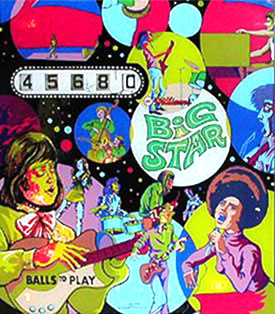 This one-player September release was designed by Steve Kordek with art package laid out by Christian Marche. 1,130 units were made, which is a pretty low production run. This is an add-a-ball game with a replay version also released called “Superstar.” This machine incorporates not one but three pop-up posts to deflect the ball from draining through the side drains as well as the flipper drain. The object of the machine is to extend your playing time by winning more free balls. This is achieved by completing the s-u-p-e-r roll-overs at the top of the play field. Doing so lights the hidden center kick-out hole. By dropping the target in front of this hole, one has a shot at the extra ball prize. If both specials are lit, two free balls are awarded. Completing each five-star sequence also advances the center shot award. Score is another to earn extra balls per game. Replay games were much more popular back in this era, but not every locale allowed replays.
This one-player September release was designed by Steve Kordek with art package laid out by Christian Marche. 1,130 units were made, which is a pretty low production run. This is an add-a-ball game with a replay version also released called “Superstar.” This machine incorporates not one but three pop-up posts to deflect the ball from draining through the side drains as well as the flipper drain. The object of the machine is to extend your playing time by winning more free balls. This is achieved by completing the s-u-p-e-r roll-overs at the top of the play field. Doing so lights the hidden center kick-out hole. By dropping the target in front of this hole, one has a shot at the extra ball prize. If both specials are lit, two free balls are awarded. Completing each five-star sequence also advances the center shot award. Score is another to earn extra balls per game. Replay games were much more popular back in this era, but not every locale allowed replays. -
 Gottlieb produced a few baseball-themed games, but Williams Manufacturing was the king of these types of games. This game, designed by Ed Krynski with art by Gordon Morison, had a run of 775 units. This is the add-a-ball version of this game, so it is rarer. The replay version is called Grand Slam. This game has eject holes which activate the roto-target, a Gottlieb exclusive device, which stops and a man is lit on a corresponding base to the eject hole on the baseball diamond. The rollover button lights when the bases are loaded. This scores 1,000 points whenever the bases are loaded. Runs and score are the ways to win free balls with this game.
Gottlieb produced a few baseball-themed games, but Williams Manufacturing was the king of these types of games. This game, designed by Ed Krynski with art by Gordon Morison, had a run of 775 units. This is the add-a-ball version of this game, so it is rarer. The replay version is called Grand Slam. This game has eject holes which activate the roto-target, a Gottlieb exclusive device, which stops and a man is lit on a corresponding base to the eject hole on the baseball diamond. The rollover button lights when the bases are loaded. This scores 1,000 points whenever the bases are loaded. Runs and score are the ways to win free balls with this game. -
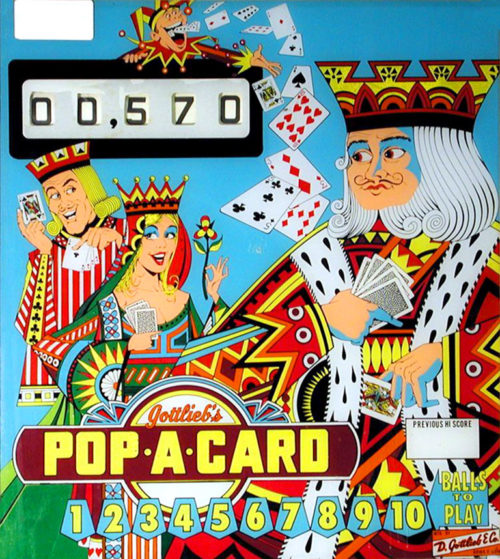 Gottlieb Pop-A-Card was another classic ‘70s playfield designed by Ed Krynski with artwork by Gordon Morison. Only 825 of these units were made. The replay version of the game was called Drop–A-Card which, as usual, was a much higher produced machine. The open playfield of this game gives ample room for scoring the three banks of drop targets. To win free balls with this game, you have to either complete the 2, 3, 4, and 5 targets, or the 6, 7, 8, and 9 targets…or the 10, J, Q, K, and Ace targets. The first two options light the wow feature to award free balls during that ball in play. If you hit the 10 thru Ace targets to completion, four rollovers light up to score extra balls. Of course, score is another way to score more balls.
Gottlieb Pop-A-Card was another classic ‘70s playfield designed by Ed Krynski with artwork by Gordon Morison. Only 825 of these units were made. The replay version of the game was called Drop–A-Card which, as usual, was a much higher produced machine. The open playfield of this game gives ample room for scoring the three banks of drop targets. To win free balls with this game, you have to either complete the 2, 3, 4, and 5 targets, or the 6, 7, 8, and 9 targets…or the 10, J, Q, K, and Ace targets. The first two options light the wow feature to award free balls during that ball in play. If you hit the 10 thru Ace targets to completion, four rollovers light up to score extra balls. Of course, score is another way to score more balls.